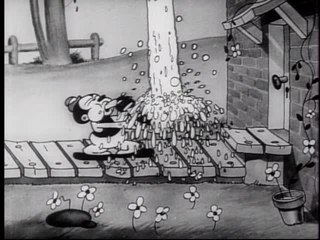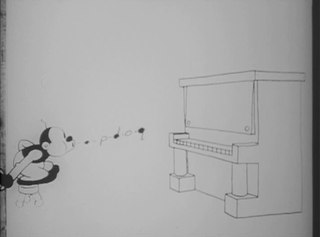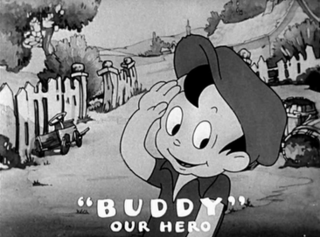Related Research Articles

Leon Schlesinger was an American film producer who founded Leon Schlesinger Productions, which later became the Warner Bros. Cartoons studio, during the Golden Age of American animation. He was a distant relative of the Warner Brothers. As head of his own studio, Schlesinger served as the producer of Warner's Looney Tunes and Merrie Melodies cartoons from 1930, when Schlesinger assumed production from his subcontractors, Harman and Ising, to 1944, when Warner acquired the studio.

Bosko is an animated cartoon character created by animators Hugh Harman and Rudolf Ising. Bosko was the first recurring character in Leon Schlesinger's cartoon series and was the star of thirty-nine Looney Tunes shorts released by Warner Bros. He was voiced by Carman Maxwell, Johnny Murray, and Billie "Buckwheat" Thomas during the 1920s and 1930s and once by Don Messick during the 1990s.
Hugh Harman and Rudolf Ising were an American animation team and company known for founding the Warner Bros. and Metro-Goldwyn-Mayer animation studios. In 1929, the studio was founded under the name Harman-Ising Productions, producing Looney Tunes and Merrie Melodies for Leon Schlesinger from 1930 to 1933. From 1934 to 1938, Harman-Ising produced the Happy Harmonies series, with William Hanna as their employee.

Buddy is an animated cartoon character in the Looney Tunes series by Leon Schlesinger Productions. He was the second star of the series, after Bosko.

Bosko the Doughboy is a one-reel 1931 short subject animated cartoon, part of the Bosko series. It was directed by Hugh Harman, and first released on October 17, 1931 as part of the Looney Tunes series from Harman-Ising Productions and distributed by Warner Bros.

Sinkin' in the Bathtub is the first Warner Bros. theatrical cartoon short as well as the first of the Looney Tunes series. The short debuted in April 1930, at the Warner Bros. Theater in Hollywood. The cartoon features Bosko, and the title is a pun on the 1929 song Singin' in the Bathtub. The film was erroneously copyrighted under the same title as the 1929 song. It is now in the public domain in the United States as the copyright was not renewed.

Bosko, the Talk-Ink Kid is a 1929 live-action/animated short film produced to sell a series of Bosko cartoons. The film was never released to theaters, and therefore not seen by a wide audience until 2000 on Cartoon Network's television special Toonheads: The Lost Cartoons. The film was produced on May 29, 1929 and directed by Hugh Harman and Rudolf Ising.

Congo Jazz is a Looney Tunes cartoon starring Warner Bros.' first cartoon star, Bosko. The cartoon was released on August 9, 1930. It was distributed by Warner Bros. and The Vitaphone Corporation. Congo Jazz was the first cartoon to feature Bosko's falsetto voice that he would use for the bulk of the series' run. It has the earliest instance of a "trombone gobble" in animation.

Hold Anything is the third short in the Looney Tunes series from Warner Bros., released to theaters in October 1930. Featuring Bosko, it is loosely based on the lost film Hold Everything, one of whose songs, "Don't Hold Everything," features prominently in the cartoon. It was directed by Hugh Harman and Rudolf Ising, and animated by Isadore "Friz" Freleng and Norman Blackburn.
Bosko's Picture Show is a Warner Bros. Looney Tunes animated short directed by Hugh Harman and Friz Freleng. It was the last Looney Tunes Bosko cartoon produced by Hugh Harman and Rudolf Ising for Leon Schlesinger and Warner Bros. The duo moved on to produce cartoons for MGM, the first of which were released in 1934. The music score was a work of Frank Marsales.

The Booze Hangs High, released in December 1930, is the fourth title in the Looney Tunes series. The short features Bosko, Warner Bros.' first cartoon character.
Bosko's Parlor Pranks is a 1934 Happy Harmonies cartoon produced by Hugh Harman and Rudolph Ising for Metro-Goldwyn-Mayer starring their character Bosko. It is the first Bosko cartoon produced in color, and the first made at MGM following the Harman-Ising studio ending its deal to produce Looney Tunes and Merrie Melodies for Warner Bros. and Leon Schlesinger. Warner Bros. would later own Happy Harmonies and the MGM cartoon studio through its Turner Entertainment Co. banner.

Buddy's Day Out is a 1933 Warner Bros. Looney Tunes cartoon, directed by Tom Palmer. The short was released in theaters on September 9, 1933, premiering with Goodbye Again, and was the first cartoon to feature Buddy, the second star of the series who was created by Earl Duvall.
Bosko the Musketeer is an American animated short film. It is a Looney Tunes cartoon, featuring Bosko, the first star of the series. It was released on August 12, 1933, although some sources note September 16 as a date; this is problematic, as that would imply that the last films featuring Bosko as the star of Warner Bros. cartoons were released after the first film featuring Buddy, the second star of the series. It was, like most Looney Tunes of the time, directed by Hugh Harman; Frank Marsales was the musical director.

Bosko's Holiday is a one-reel 1931 short subject animated cartoon, part of the Bosko series. It was directed by Hugh Harman, and first released on July 18, 1931 as part of the Looney Tunes series from the Leon Schlesinger animation studio and distributed by Warner Brothers. The film score was composed by Frank Marsales.
Big Man from the North is an American animated short film. It is a Looney Tunes cartoon, featuring Bosko, the first star of the series. It was released in January 1931, although some sources give an unspecified date in 1930. It was, like most Looney Tunes of the time, directed by Hugh Harman and Rudolf Ising; Frank Marsales was the musical director.
Ups N' Downs is a 1931 Looney Tunes cartoon featuring Bosko. It was released in April 1931 and is directed by Hugh Harman and Rudolf Ising. The film score was written by Frank Marsales.

Dumb Patrol is a 1931 one-reel short subject, part of the Looney Tunes series. It was released in May 1931 and is directed by Hugh Harman and Rudolf Ising. The film score was composed by Frank Marsales.
Bosko's Soda Fountain is a 1931 one-reel short subject featuring Bosko as part of the Looney Tunes series. It was released on November 14, 1931 and was directed by Hugh Harman. The film score was composed by Frank Marsales.

Bosko's Store is a 1932 Warner Bros. Looney Tunes cartoon directed by Hugh Harman. It was released on August 13, 1932, and stars Bosko, the first star of the series. As is the case with most Looney Tunes of its time, it was directed by Hugh Harman and its music scored by Frank Marsales.
References
- ↑ Beck, Jerry; Friedwald, Will (1989). Looney Tunes and Merrie Melodies: A Complete Illustrated Guide to the Warner Bros. Cartoons. Henry Holt and Co. p. 15. ISBN 0-8050-0894-2.
- ↑ Lenburg, Jeff (1999). The Encyclopedia of Animated Cartoons. Checkmark Books. pp. 57–58. ISBN 0-8160-3831-7 . Retrieved June 6, 2020.
- ↑ Schneider, Steve (1988). That's All, Folks! : The Art of Warner Bros. Animation. Henry Holt and Co. p. 40. ISBN 0-8050-0889-6.
- ↑ "Catalog of Copyright Entries". U.S. Govt. Print. Off. 1961. Retrieved November 7, 2019.